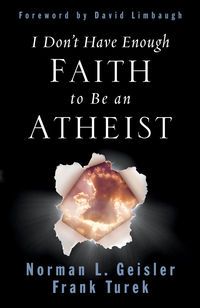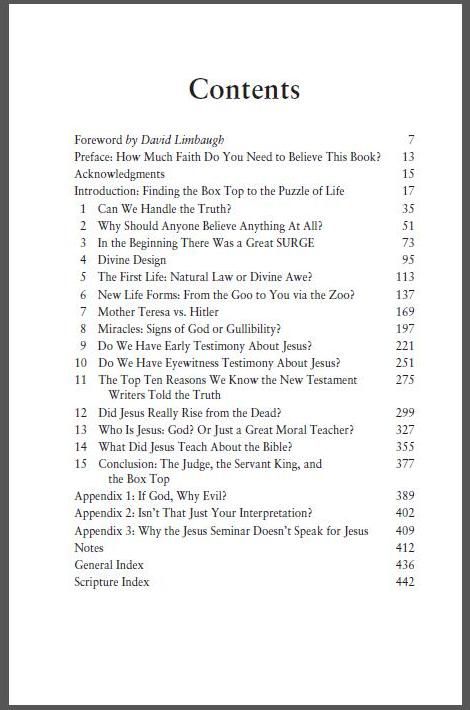Through the blessing of the TOS Review Crew, I recently received and read
I Don't Have Enough Faith to be an Atheist and its accompanying workbook, published by
Apologia. Written by Norman Geisler and Frank Turek, this book challenges the very popular notion that faith in God is irrational, asserting instead that not only is such belief rational, but it is actually more rational than the alternative.

While I will always cite St. Thomas Aquinas' Summa Theologica as the preeminent argument for the existence of God, there is much to recommend this book. First, although it is a hefty book, weighing in at 448 pages, it doesn't read like a hefty book. Although the material is weighty, it is eminently readable. Addressing such questions as "Why should anyone believe anything at all," "Do we have eyewitness testimony about Jesus," and "Who is Jesus: God, or just a great moral teacher," the book tackles head-on the questions often asked by agnostics. In my experience, atheists rarely ask such questions, as they are not interested in learning the truth. I have found the sole goal of many atheists to be simply trying to make Christians appear foolish. I don't feel that such people are the intended audience of this book. Rather, this book should be embraced by Christians who want to be able better to understand their faith and to engage in more sophisticated apologetics, and by agnostics, or those people who truly are on a search for truth.

Chapters are introduced by way of a brief outline summarizing the main points, such as this one from Chapter 8:
Chapters conclude with a summary of what was covered. If you're like me, books like this one are very easy to read. You are told what to expect, the material is covered, and, finally, a summary is presented.
While anyone can make arguments against the existence of God, making arguments for the existence of God is a trickier proposition, given that if you have to be convinced of God's existence, you have probably not yet discovered the great gift of faith. Geisler and Turek don't let this fact slow them down, though. It would be impossible for me to do justice to their work, but this snippet of a conclusion is a great example of their clear and cogent (not to mention convincing) style:
Along with the book, I also received the companion
workbook.
The workbook (called a curriculum on the cover) is comb bound and comes in at nearly 300 pages. Not for the faint of heart (or children younger than high school), there is an amazing amount of material here. Correlated to the chapters in the book, the workbook contains supplemental material, study questions, and activities for personal reflection, discussion, and writing. The authors suggest that each chapter, including the workbook section, should take 2-3 weeks to cover.
Each workbook chapter is divided into the following sections:
- Hook - a reminder of what the chapter covered and questions to warm up the brain
- Book - a deeper look at the specific issues covered in the chapter
- Look - research assignments and suggested activities
- Took - a summary of the material and concepts
There are also free downloadable chapter tests and solutions available online from Apologia. The workbook is a worthy companion to the book and is definitely worth purchasing to make this a complete one-year apologetics course. A
sample chapter from the workbook is available on Apologia's
website.
I had thought to use this curriculum with my oldest daughter, but ended up using it myself. Therese is only 11, and we are focusing on Catholic apologetics with her at this age (Mary, the saints and angels, the Eucharist, etc.). I really enjoyed the book and the workbook, though. Being firmly grounded in Catholic apologetics, I did not have a problem dealing with things on which I differ with most Protestants (e.g., evolution). I found those sections of the book interesting, but, ultimately, not convincing. Because other parts of the book are so good, though, I definitely see having Therese work through this curriculum in a few years. I wouldn't recommend it for Catholics who are not well-versed in Catholic theology, because there are obviously some key differences between Catholic and Protestant thought. For those who can separate out those differences, though, I think this is a good book.
Because I did not have the book long enough to use the entire package as a curriculum, I focused my efforts on the book, completing only two chapters in the workbook (although I read the whole workbook - the biographical profiles contribute to making the workbook read like an entirely different book). Because of its readability, I was able to read I Don't Have Enough Faith to be an Atheist in about a week. I began telling people about how much I liked this book after reading only the first chapter. When I was done with the book, I went back to the workbook and completed the writing and thinking exercises for the first two chapters (this approach is the one that I used because of the time constraints of a review period). I would not be recommending the purchase of the workbook/curriculum guide if I did not think that it added significantly to the experience with the book as a whole. I would encourage you to look at the sample chapter if you are considering not purchasing the workbook - for the reasonable price you might just change your mind!
I Don't Have Enough Faith to be an Atheist is available for $16, and the workbook costs $33.00. Both can be purchased from
Apologia.

Disclaimer: I received both the book I Don't Have Enough Faith to be an Atheist and the accompanying workbook free in exchange for my review. I received no other compensation.







































